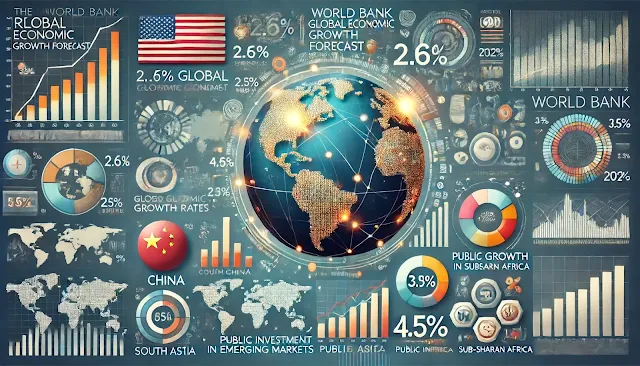World Bank Adjusts Global Economic Growth Forecast for 2024
Introduction
The World Bank (WB) has recently revised its global economic growth forecast for 2024, increasing it to 2.6%, up from the initial 2.4% projection made in January 2024. This adjustment reflects positive economic developments in major economies, particularly the United States, and is expected to have significant implications for both developed and emerging markets.
Global Economic Outlook
The updated forecast by the World Bank indicates a slight improvement in global economic growth, with projections now at 2.6% for 2024. This increase of 0.2 percentage points from the previous forecast is driven by strong economic performance in the United States and other large economies. However, the growth rate remains below pre-pandemic levels, which were around 3.1% (World Bank) (THE VOICE OF VIETNAM).
Regional Highlights
United States: The U.S. economy is a significant contributor to the revised forecast, with expected growth driven by strong consumer spending and robust investment activities. The potential growth rate of the U.S. economy could ramp up to 2.5% per annum by the end of the decade (THE VOICE OF VIETNAM).
China: China, the world’s second-largest economy, is forecasted to grow at 4.8% in 2024. This is an increase of 0.3 percentage points compared to the January forecast but still reflects a slowdown due to challenges in the real estate sector (THE VOICE OF VIETNAM).
South Asia: Growth in the South Asia region, primarily driven by India, is projected to slow slightly to 6.2% in 2024. This moderation is due to a high base of growth in recent years and ongoing geopolitical and economic risks (World Bank).
Sub-Saharan Africa: Growth in this region is expected to pick up to 3.5% in 2024, driven by improvements in private consumption and investment. However, political instability and high debt levels continue to pose significant risks (World Bank).
Comparative Market Analysis
Comparing global and domestic markets, emerging markets and developing economies (EMDEs) are expected to grow at a rate of 4%, slightly higher than previous forecasts. This growth is still below pre-pandemic levels and is influenced by factors such as public debt challenges and limited trade (THE VOICE OF VIETNAM).
Developed Markets: In contrast, developed markets are experiencing slower growth. The U.S. and European economies are recovering at a modest pace, with growth driven by consumer spending and fiscal support measures.
Emerging Markets: Emerging markets like China and India are showing robust growth, although they face unique challenges such as real estate market slowdowns and geopolitical risks. These economies are benefiting from strong domestic demand and government support.
Strategic Insights for Investors
Diversify Investments: Given the varied growth rates across regions, investors should consider diversifying their portfolios to include both developed and emerging markets. This approach can help mitigate risks associated with regional economic fluctuations.
Monitor Economic Indicators: Staying informed about global economic trends and regional developments is crucial. Key indicators such as GDP growth rates, inflation, and trade balances can provide valuable insights for making informed investment decisions.
Focus on High-Growth Sectors: Sectors such as technology, infrastructure, and consumer goods are expected to perform well in both developed and emerging markets. Investing in these sectors can provide stability and growth potential.
Frequently Asked Questions (FAQ)
Q1: Why did the World Bank revise its global growth forecast? The revision is due to stronger-than-expected economic performance in major economies, particularly the United States, and positive developments in other large economies like China and India.
Q2: What are the main risks to the global economic outlook? Key risks include geopolitical tensions, high public debt levels, and potential economic slowdowns in major economies. Additionally, climate-related disasters and fiscal constraints in developing countries pose significant challenges.
Q3: How are emerging markets expected to perform in 2024? Emerging markets are forecasted to grow at a rate of 4%, driven by strong domestic demand and government support. However, these markets face challenges such as political instability and high debt levels.
Q4: What investment strategies should be considered in light of the new forecast? Investors should diversify their portfolios, monitor key economic indicators, and focus on high-growth sectors such as technology and consumer goods to navigate the current economic landscape effectively.
Conclusion
The World Bank’s revised global growth forecast for 2024 offers a cautiously optimistic outlook, with improvements driven by strong performances in major economies. By staying informed and strategically diversifying investments, investors can navigate the evolving economic landscape and capitalize on growth opportunities.




%20a%20line%20gra.webp)



0 Comments